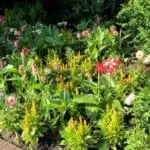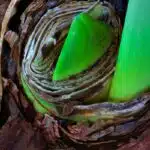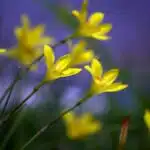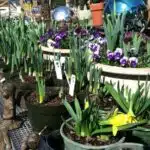Daffodils are one of the most cheerful and beloved flowers in the world. They evoke feelings of joy, hope and renewal with their vibrant yellow petals. Whether you’re looking to fill your garden with beautiful blooms or just want to add a splash of color indoors, learning how to grow and care for daffodils is essential. In this article, we will provide simple instructions on how to plant and maintain these beautiful flowers.
By following our guide, you can create a stunning display of daffodils in your garden or home that will bring cheer and delight all year round. From choosing the right location and soil type to ensuring they get enough sunlight, water and fertilizer, we’ll provide step-by-step instructions so that anyone can be successful when growing daffodils. Plus, we’ll also cover basic maintenance tips so that you can keep your daffodils looking their best throughout the season.
With our helpful advice, you can enjoy the beauty of these lovely flowers in no time at all! So what are you waiting for? Let’s get started on creating a beautiful garden full of bright yellow blooms!
Choose The Right Location For Planting
Planting daffodils can be a great way to add a splash of color to your garden. While it takes some effort and time, the end result is sure to be worth it. But where should you start?
When it comes to growing daffodils, location is key. It’s important to choose a spot that gets adequate sunlight — usually about six hours per day — and good drainage for the best results. Additionally, planting in an area with air circulation will help prevent fungal diseases from developing.
It’s also important to think about what other plants your daffodils will be sharing the space with, as some varieties may require more sun or shade than others. Taking all these factors into consideration when choosing your location can help ensure that your daffodils thrive and flower year after year. With the right spot picked out, you’ll be ready to move on to preparing the soil for planting!
Prepare The Soil For Planting
What an amazing coincidence that you have landed here just as we are about to talk about preparing the soil for planting daffodils! Planting these colourful flowers is a great way to add beauty and cheer to your garden. Let’s take a look at how you can get started.
When preparing the soil for planting daffodils, it’s important to choose a spot with plenty of sunlight and well-drained soil. If possible, test the pH level of the soil so it’s not too acidic or alkaline. The ideal pH level should be between 6 and 7, but slightly alkaline soils can also work well. Additionally, if your soil is heavy clay or hard-packed, mix in some compost or other organic matter to improve drainage.
After selecting an appropriate location and testing the soil, you’ll need to dig out holes that are around 4 inches deep and apart from each other by at least six inches. This will give your bulbs enough room to grow without being crowded together. Finally, consider adding mulch around the planted bulbs after they’ve been put in the ground; this will help keep them moist and protected during cold weather spells.
Now that you’ve prepared the perfect environment for your daffodils, it’s time to plant those bulbs!
Plant The Bulbs
Planting daffodil bulbs is an easy and rewarding activity. To illustrate, take the case of Jane who is planting daffodils in her garden for the first time. She carefully selected a spot in her backyard that gets plenty of sun and dug holes about four to six inches deep. Then she placed three or four bulbs into each hole with the pointed end facing upward. After making sure that the bulbs were securely placed, she filled the holes with soil and patted them down gently.
Jane then added some mulch around each bulb to help keep moisture levels even during dry spells. But it’s important not to mound up too much mulch over the bulbs as it can cause rot. Finally, she gave each bulb a drink of water to help settle it in its new home.
Now that Jane’s daffodils are planted, they will need plenty of sunlight to grow and bloom. TIP: For best results, make sure your daffodils get at least 6 hours of direct sunlight every day! With proper care and attention, Jane’s garden will be full of beautiful blooms come springtime!
Sun Requirements
We all have our hopes and dreams for the future, and there’s no better way to make them come true than with a daffodil garden! Of course, you’ll need to know how to provide it with the proper care in order to ensure that your garden is healthy and blooming. Sun requirements are one of the most important considerations, so let’s take a look at how much sun daffodils need.
Daffodils require full sun or partial shade when grown outdoors. If possible, try to select a location that gets at least six hours of direct sunlight per day. This will help ensure that your daffodils receive enough light to properly grow and flower. Additionally, make sure that the area you choose has well-draining soil since daffodils don’t like wet feet.
It’s also important to note that too much sun can be damaging for daffodils. If your garden is in an area with intense sunlight or heat during certain times of the day, consider providing some shade with trees or other plants during these periods. With this in mind, you’ll be able to give your daffodils just the right amount of sun they need for optimal growth.
Now that we’ve covered the basics of sun requirements for growing daffodils, let’s move on to discussing watering needs…
Watering Requirements
Watering your daffodils is an essential step in keeping them healthy and happy. With the right balance of water, your daffodils will thrive and provide you with years of beautiful blooms. Knowing when and how much to water can be tricky, but it’s important to get it right if you want to keep your daffodils looking their best.
First, you should water your daffodils as soon as possible after planting. Make sure the soil is thoroughly moistened without being soggy or flooded. After that, plan on watering your plants at least once a week during the growing season, more often in hot weather or if the soil dries out quickly. Avoid getting water on the foliage of your daffodils as this can cause rot and disease. If necessary, use a soaker hose or drip irrigation to be sure only the roots are getting wet.
In addition to regular watering, you’ll also need to pay attention to drainage in order for your daffodils to stay healthy. Be sure that any excess water can easily drain away from their roots and doesn’t stand around too long before evaporating. This is especially important during winter dormancy when standing water can cause root rot or other problems. With proper care and attention, you can ensure that your daffodils have all they need for a long and successful life in your garden!
Keeping up with these watering requirements will help ensure that your daffodils have the moisture they need throughout the year while avoiding damage caused by overwatering or standing water. Now let’s look at how fertilizing can further benefit these lovely flowers…
Fertilizing
It is often said that fertilizing is the key to growing healthy and vibrant daffodils. But could this be true? To find out, let’s explore the necessary steps for successful fertilizing of daffodils.
Firstly, it is important to begin fertilizing your daffodils in early spring after they are done blooming. Secondly, use a balanced fertilizer with low nitrogen levels so as not to encourage too much foliage growth at the expense of flower production. Finally, apply the fertilizer using one-third of the recommended rate on the package directions and repeat every four to six weeks until autumn.
By following these steps, you can provide your daffodils with just enough nutrients without overdoing it. Doing so will ensure that they stay healthy while also producing beautiful blooms year after year! By providing your plants with proper nutrition, you can enjoy their beauty and contribute towards making the world more vibrant—all while serving others through gardening.
Now that we have established how to properly fertilize our daffodils, let’s take a look at mulching them for best results…
Mulching
Mulching is an important step in growing and caring for daffodils. Consider the case of Mrs. Brown, a home gardener who wanted to add some life and color to her garden. She decided to plant daffodils and knew that mulching would be essential to their success. Here are a few tips on how mulching can help grow and care for daffodils:
- Mulch helps to conserve moisture by slowing evaporation from the soil surface, which is important for daffodil bulbs during dry periods.
- It also helps to keep weeds down, so that the bulbs don’t have to compete for resources with other plants or grasses in the area.
- Finally, mulch adds nutrients back into the soil as it decomposes over time, providing extra nourishment for your bulbs and flowers.
When applying mulch around your daffodil beds, make sure not to cover up any emerging foliage or flowers because this can damage them as they come through the soil’s surface. A light layer of organic material will help keep moisture levels consistent and provide insulation against extreme temperatures. With proper mulching techniques, you can create an environment where your daffodils can thrive!
Next up in our guide on how to grow and care for daffodils is deadheading – a process of removing faded blooms off of the stems after they’ve already been pollinated. This simple task encourages additional blooms throughout the season while also helping with overall plant health.
Deadheading
It’s time to move on to the next step in daffodil care, deadheading! This is like a spring cleaning for these beautiful flowers. Think of it as a chance to give them a fresh start and encourage new growth. To do this, simply remove the spent blooms and leaves from the stem, allowing the energy of the plant to focus on producing new blooms. It’s like giving your plants a much needed makeover!
It’s important to know that deadheading isn’t just about aesthetics; it can also help keep your daffodils healthy. By removing spent blooms, you’re preventing fungal diseases caused by wet, rotting petals sticking around too long. Plus, it’ll help conserve water and nutrients for new growth.
TIP: When deadheading, it’s best to trim stems at an angle so that water doesn’t collect in pools along the stem after watering your daffodils. This helps prevent fungal diseases from taking root and will keep your plants looking their best!
Pest And Disease Control
Good news! You’ve planted and grown your daffodils and now they’re looking beautiful. But with any flower, there’s always the potential for pesky pests or disease to set in. If you want to keep your flowers looking their best, it’s important to have a plan in place for pest and disease control.
The first step is prevention: make sure you are planting in an area of your garden that has plenty of bright sunlight and is well-drained. Choose appropriate fertilizers, such as those specifically made for bulbs, and use them according to the manufacturer’s instructions. Finally, avoid over-watering – this can lead to rot, which will decrease the lifespan of your daffodils.
If you do notice signs of pests or disease on your daffodil plants, don’t panic! There are easy steps that you can take to mitigate any damage. Start by removing affected leaves or flowers from the plant as soon as possible – this will help reduce the spread of any bugs or fungus throughout the garden. Additionally, you may want to invest in some natural bug repellents like neem oil or garlic solutions. TIP: Make sure you check with your local gardening store before applying anything to your plants – they may have specialized advice for pests in your area.
Digging And Storing Daffodil Bulbs
Digging and storing daffodil bulbs is an important step in caring for these beautiful flowers. Knowing when and how to do this will ensure your daffodils have the best chance of blooming year after year. To help you out, we’ve put together a guide on digging and storing daffodil bulbs.
When it comes to digging up daffodil bulbs, timing is everything. You should wait until the foliage has died back before beginning to dig. This will give the bulb enough time to store enough energy for flowering again in subsequent years. Once the foliage has died back, you can begin carefully digging and removing the bulbs from the ground. Make sure you don’t damage them as this could affect their ability to flower again in future years.
It’s also important that you properly store your daffodil bulbs once they are dug up. The ideal temperature for storing them is around 40 degrees Fahrenheit (4 degrees Celsius). Place your daffodil bulbs in a paper bag or cardboard box with some peat moss or sawdust sprinkled at the bottom to keep them dry and cool during storage. Then, when spring rolls around again, you can bring out your stored daffodil bulbs and replant them so they can bloom once more!
Now that you know how to dig up and store your daffodils, it’s time to learn about propagating them so you can increase your collection even more!
Propagation Of Daffodils
Propagating daffodils is a great way to expand your garden and enjoy the beauty of these flowers for years to come. It’s a fairly straightforward process, but following these steps will ensure you get the most out of it. Here’s how to propagate daffodils successfully:
- Gather the materials you’ll need: daffodil bulbs, potting soil, and pots or trays.
- Select healthy bulbs that are at least two years old and have multiple eyes (growing points).
- Prepare the soil by mixing it with an equal amount of sand or perlite to improve drainage.
- Plant the bulb with its pointed top facing up in a shallow hole filled with soil mixture.
- Water well and place in a sunny location until new leaves appear, then move to a partially shaded area and water regularly during dry periods.
With these simple steps, you can easily propagate your own daffodils and enjoy them for many years to come! Now that you know how to propagate, it’s time to learn about dividing daffodils so they continue blooming year after year without overcrowding their space. Understanding when and how to divide your plants is key to keeping them healthy and happy over time.
Dividing Daffodils
It’s almost like a rite of passage for green thumbs: the need to divide daffodils. It’s a symbolic step, in a way, signalling that one has gained enough knowledge and confidence to take on more challenging tasks. But when it comes to dividing daffods, don’t be intimidated! It’s actually quite simple – you just need a little bit of know-how.
The process of dividing daffodils is fairly straightforward. The best time to do so is after the plant blooms and the foliage has died back. You should then dig up the entire clump and shake off any excess dirt. Once you have done this, you can then carefully pry apart or cut the roots with a sharp knife or shears if necessary. Be sure that each division contains at least one growing point, or else they won’t grow again!
When it comes to transplanting your newly divided plants, make sure to use a soil mix specifically designed for bulbs and give them plenty of sunshine. Water them regularly as well – especially during dry spells – and mulch around them in colder climates to help protect them from frost damage in winter months. Proper care will ensure that these beautiful blooms come back year after year! Now that we’ve discussed dividing daffodils, let’s take a look at some common varieties…
Common Daffodil Varieties
The beauty and fragrance of daffodils, reminiscent of springtime, has long enticed gardeners to seek out these beloved flowers. With the variety of colors and shapes available in these blooms, it’s no wonder that they have become a staple of many gardens. Now, let’s explore some common varieties of daffodils and find the perfect one for you.
For those looking for a show-stopping centerpiece, look no further than the magnificent King Alfred daffodil. It offers multiple layers of large blooms with bright yellow petals and a deep orange cup in the center. Another stunning variety is the classic Poet’s Narcissus which produces white petals with a yellow-orange cup center.
For something more subtle yet still eye catching, there are varieties like Jetfire or Tete-A-Tete that offer smaller blooms with white petals and an orange cup center. For an additional touch of color, try out varieties such as Thalia or February Gold with their buttery yellow petals and bright orange centers.
With so many different types to choose from, you can select the perfect set to create a beautiful display in your garden this season.
Design Ideas For Planting Daffodils
A stitch in time saves nine” is an adage that aptly applies to the success of planting and growing daffodils. Designing a garden space with these flowers in mind can make all the difference between a failed crop and one that is abundantly enjoyed. Here, we will explore some design ideas for planting daffodils.
When considering placement, consider how much sun the area gets and if it’s protected from strong winds. Knowing this information, you can decide which varieties of daffodils best suit your climate. Additionally, take into consideration the soil type and drainage – as daffodils love moist soils but not soggy ones! Finally, plan out the area you want to plant in advance so you have an idea of what you need to buy for supplies such as bulbs or fertilizer.
To create natural looking arrangements, think about mixing different varieties together. Doing this helps create a vibrant display with various colors and heights that look beautiful once they start blooming. You can also incorporate other plants and structures into your design such as rocks or boulders, trees, shrubs, or even walls – all of which add texture and create more interest in your garden space.
By following these design tips for growing daffodils, you are sure to have stunning results come springtime! With thoughtful planning in advance and consideration of environmental needs like sunlight, soil type, drainage etc., you can create a unique garden oasis that both yourself and others will enjoy for years to come.
Design Tips For Growing Daffodils
As you plan to grow daffodils, it is important to remember that a little bit of effort goes a long way. Like any flower, these bright, cheerful blooms require some care and attention if you want them to reach their full potential. To help make your gardening experience easier and more successful, here are a few design tips for growing daffodils that will have your garden looking its best in no time.
Let’s start off with an inspiring thought: when it comes to planting daffodils, the possibilities are truly endless! Here are four ways to bring your garden alive with these beautiful flowers:
- Plant bulbs in clusters of three or more for the most impact.
- Place taller varieties behind shorter ones for a pleasing visual balance.
- Utilize edging plants to create neat borders around flower beds.
- Liven up pathways by using potted daffodils near doorways or entrances.
When you’re ready to start planting, be sure to choose an area of your yard that has well-draining soil and plenty of sunshine – daffodils need about six hours of sun per day for optimal health and growth! You’ll also want to keep them away from trees and other plants that may compete for nutrients as they grow over time. Additionally, if your climate is especially cold and wet during winter months, it might be best to invest in hardy varieties such as jonquils or tazettas which can handle harsher conditions better than other types of bulbs can.
With proper planning and care, you can enjoy vibrant displays of daffodils throughout the year! With some creative thinking and a bit of know-how, you’ll soon be able to create stunning gardens filled with these lovely flowers – sure to lighten up any home or landscape!
Frequently Asked Questions
How Long Do Daffodils Live?
A perennial in more than just name, daffodils are a bright addition to any garden that you can enjoy for years to come. Like the saying goes, when it comes to these flowers, “What’s planted in spring, blooms in the summer”. So how long do they last?
When properly cared for, daffodils will return year after year. With proper planting and maintenance, they can live up to 8-10 years or longer. To ensure success with your daffodil garden and give them their best chance at a long life, make sure you’re giving them the right environment and care. Planting in well-drained soil is key to keeping your daffodils healthy through any season. Keep them watered and fertilize regularly so that they can reach their full bloom potential each year.
With all of this effort put into caring for your flowers you’ll be rewarded with beautiful blooms for many years to come. Daffodils are fantastic additions to any space due to their bright colors and hardy nature—providing you with an abundance of beauty every spring! Taking proper care of them will help ensure that these cheerful harbingers of spring will be gracing your landscape for many seasons ahead.
When Is The Best Time To Plant Daffodils?
Not only do daffodils bring a vibrant splash of color to any garden, they also have the potential to live for many years. But when is the best time to plant these beautiful flowers?
Contrary to popular belief, winter isn’t necessarily the time for planting daffodils. In fact, for optimal growth and flowering, it’s best to wait until spring or early fall. Preparing the soil by digging down several inches and adding compost or fertilizer will help ensure that your daffodils are successful.
Choosing a sunny location with well-drained soil will make all the difference in how your daffodils perform. Plant bulbs in groups of three or five and cover them with six inches of soil. Water thoroughly after planting and mulch lightly once the foliage appears. With proper care and attention, you can enjoy a lovely display of blooms each spring!
How Often Should I Water Daffodils?
Watering daffodils is key to keeping them happy and healthy, but it’s important to get the frequency and amount just right. Too little water can cause the flowers to wilt or even die, while too much water can cause root rot. So, how often should you water your daffodils?
The answer depends on a few factors like soil type, temperature, and humidity. Generally speaking, it’s best to water deeply once a week during their active growing season. This means that if you’re in an area with lots of rain or higher humidity levels, you may not need to water at all. On the other hand, if your area has low rainfall or extreme heat, you may want to increase watering sessions up to two times a week.
When watering your daffodils, be sure not to over-saturate the soil as this can lead to root rot. Aim for moistening the entire root zone rather than just wetting the surface of the soil. If you are unsure about when and how much to water your daffodils, make sure that you consult with a local gardening expert for advice tailored directly for your needs!
Are There Any Special Considerations When Growing Daffodils In Containers?
Daffodils are a beautiful addition to any garden, and can even be grown in containers! But there are some special considerations to keep in mind when cultivating daffodils this way. Let’s explore what you need to know to ensure your container-grown daffodils thrive.
Growing daffodils in containers requires a bit of extra care and attention if you want them to blossom with beauty. To achieve their full potential, consider these five points:
- Choose a pot that is big enough for the plant – its root system needs room to grow.
- Use a well-draining soil mix specifically designed for containers.
- Make sure the pot gets enough light – six hours of direct sunlight is ideal.
- Water regularly but without overwatering – usually once per week should suffice.
- Add an organic fertilizer every few weeks to encourage growth and blooms.
By following these steps, your daffodils will be able to reach their fullest potential within the confines of their container home. With ample light, water, soil, and nourishment from fertilizer, they’ll be able to spread their petals wide and revel in all the beauty they have to offer. So don’t hesitate; start planting your container-grown daffodils today and enjoy their vibrant colors come spring!
Are There Any Special Fertilizers I Should Use For Daffodils?
When it comes to growing daffodils, you may be wondering if there are any special fertilizers that you should use. This is an important question because different plants require different fertilizers in order to bloom properly and stay healthy. You’ll want to make sure that your daffodils get the nutrients they need for a beautiful display of blooms.
The good news is that daffodils don’t need very specialized fertilizer. A general-purpose fertilizer will provide your daffodils with all the nutrients they need for optimal growth and flowering. It’s best to apply a balanced fertilizer such as 10-10-10 or 12-12-12 at the beginning of each growing season. If you’re planting in containers, you can also use slow-release fertilizers as well.
It’s also important to remember that too much fertilizer can be just as bad as not enough. Too much nitrogen can cause excessive foliage growth and fewer blooms, so you’ll want to follow the directions on the package carefully when applying fertilizer. In addition, don’t forget to water your daffodils regularly so they get enough moisture while they’re blooming. With the right amount of care and attention, your daffodils will thrive and bring beauty into your garden or home!
Conclusion
The beauty of daffodils is undeniable. With their bright yellow and white flowers, they are the perfect addition to any garden. But growing and caring for these beloved blooms isn’t always easy. To ensure your daffodils will thrive and live a long life, it’s important to know when and how to plant them, how often to water them, what special considerations you need for container grown plants, and which fertilizers work best for them.
In conclusion, with the right knowledge and care, daffodils can indeed be a stunning part of your garden that will last for years. This is especially true if one follows the well-established theory that the more attention one pays to their daffodils during planting season, the more likely they are to bloom in abundance each year thereafter. Thus, if you put in consistent effort during planting season—making sure soil drainage is adequate, selecting varieties suitable for your climate, watering consistently throughout the summer months—you’re sure to be rewarded with an abundance of beautiful flowering daffodils each year.
So don’t let fear of not knowing how to grow or care for daffodils keep you from enjoying their beauty! With just a little bit of research and commitment on your part, you can have a garden full of happy and healthy daffodils that will bring joy each year when they bloom in all their glory!





























